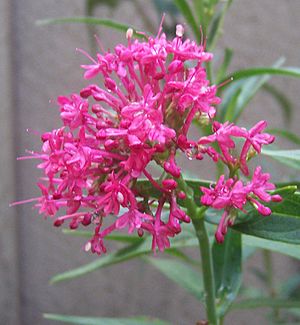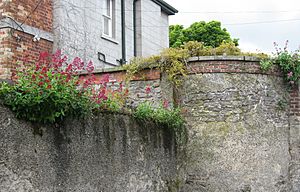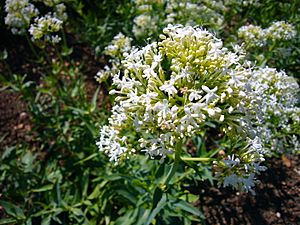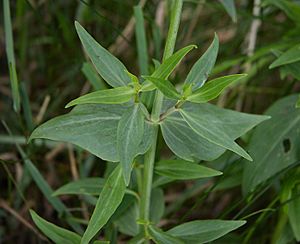Red valerian facts for kids
Quick facts for kids Red valerian |
|
|---|---|
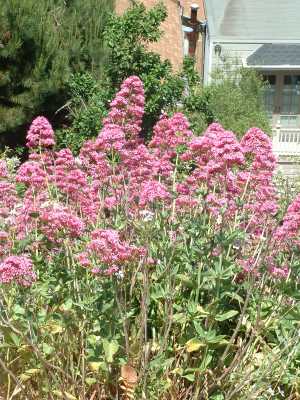 |
|
| Scientific classification | |
| Genus: |
Centranthus
|
| Species: |
ruber
|
| Synonyms | |
|
|
The Centranthus ruber, also known as red valerian, is a well-liked garden plant. People grow it because of its beautiful flowers. It has many fun nicknames like kiss-me-quick and Jupiter's beard.
Contents
What the Red Valerian Looks Like
The red valerian is a perennial plant. This means it lives for more than two years. It often grows as a subshrub, which is a small shrub. Its base is usually woody, like a small tree trunk.
The leaves are about 5 to 8 centimeters long. The leaves at the bottom of the plant have small stems, called petioles. The leaves higher up on the plant do not have these stems; they are sessile. The leaves grow in pairs on opposite sides of the stem. They are usually oval or shaped like a spear.
Flowers and Colors
This plant produces many flowers. Each flower is tiny, only about 2 millimeters wide. But they grow in large, showy groups called inflorescences. These groups are rounded clusters of small flowers. Each flower has five petals that are joined together and a small spur.
The most common color for the flowers is a brick red or purplish red. But you can also find them in deep crimson, light pink, or lavender. There is even a special type called 'Albus' that has white flowers. About 10% of red valerian plants have these white blooms.
When it Blooms
Red valerian usually starts to flower in early summer. In places with cooler summers, it can keep blooming on and off throughout the summer and into the fall. One type, called 'coccineus', is known for blooming for a very long time.
The flowers have a strong smell that some people find a bit unusual. Bees and butterflies love these flowers. The plant is known for attracting many different insects. The larvae (young forms) of some Lepidoptera (moths and butterflies), like the angle shades moth, eat this plant.
Seeds and Spreading
The seeds of the red valerian have fluffy parts, much like a dandelion seed. These fluffy parts help the seeds float away on the wind. This means the plant can easily spread its own seeds. If not managed, it can grow very quickly and take over areas.
Where the Red Valerian Grows
The red valerian originally comes from the Mediterranean region. This area includes countries around the Mediterranean Sea. Over time, people have planted it in gardens all over the world. Sometimes, it escapes from gardens and starts growing wild.
It has become a common wild plant in places like France, Australia, Great Britain, Ireland, and the United States. In the US, you can find it growing wild in western states such as Arizona, Utah, California, and Oregon. It often grows in rocky areas that have been disturbed, like roadsides or empty lots in cities. It can grow well even in very alkaline (limey) soil.
Because it can handle the lime found in mortar, red valerian is often seen growing on old walls. You can spot it on walls in Italy, southern France, and the southwest of the UK.
Why it Can Be an Invasive Plant
In some places, like the Western Cape in South Africa, the red valerian is considered an invasive plant. This means it grows so easily and quickly that it can harm local plants. It can take over their space and resources.
Because of this, in certain areas, there are rules about it. People might be asked to remove and destroy these plants. This helps protect the natural environment and native plants.
See also
 In Spanish: Centranto para niños
In Spanish: Centranto para niños


